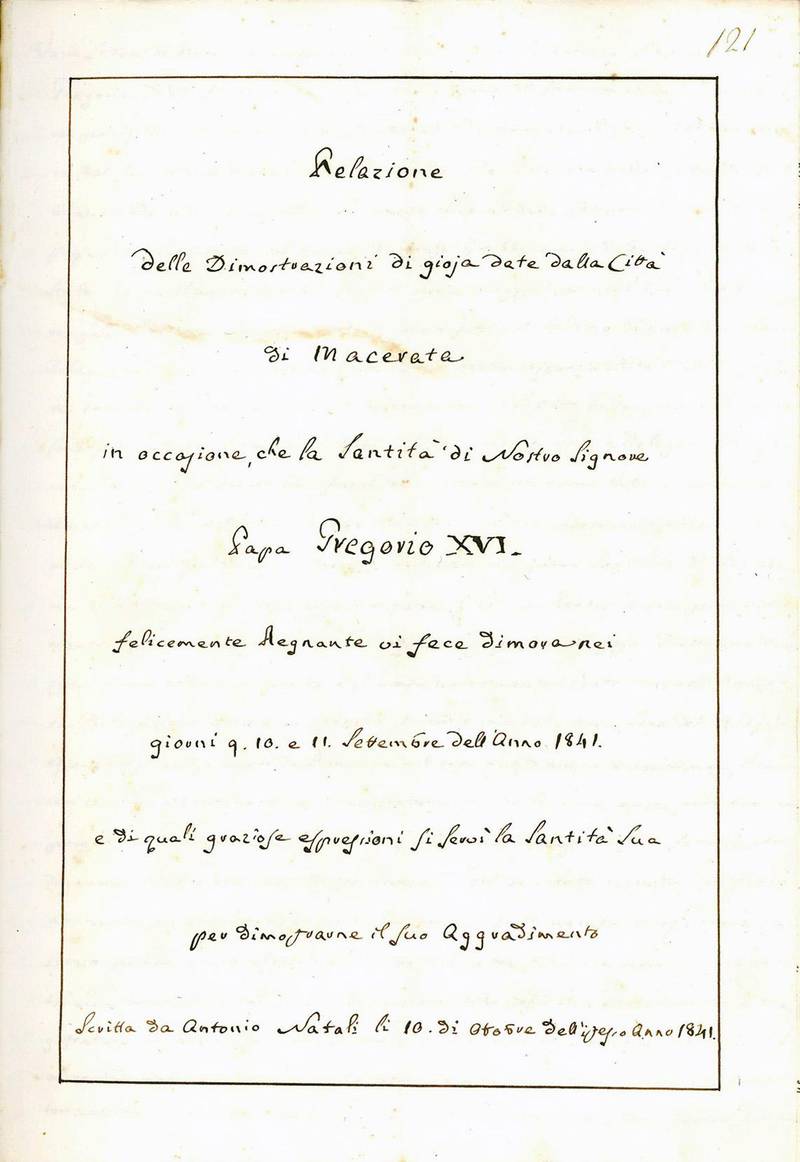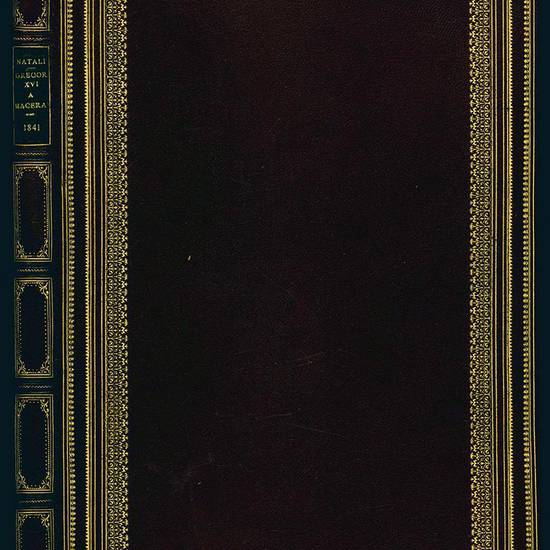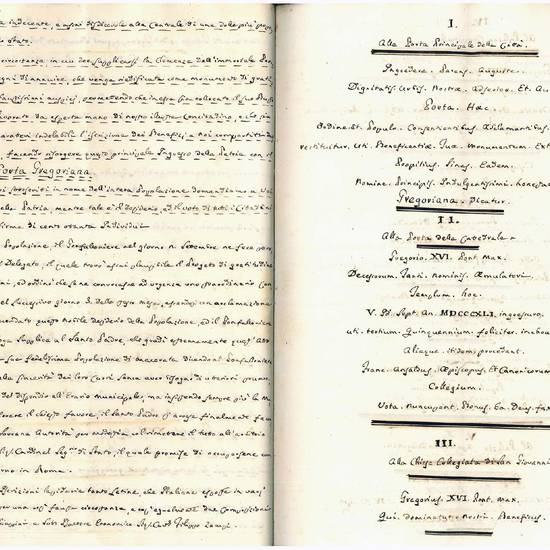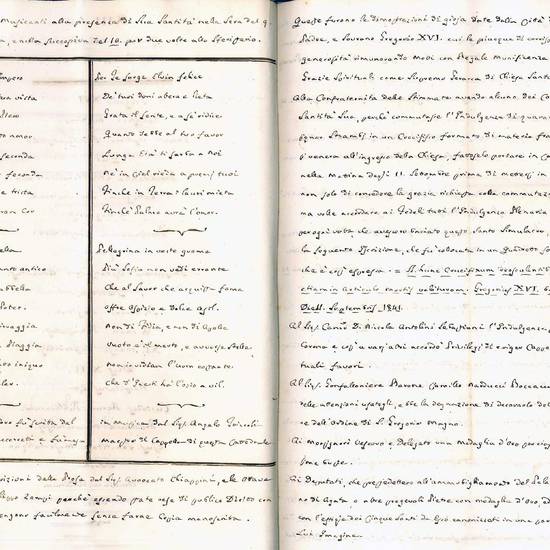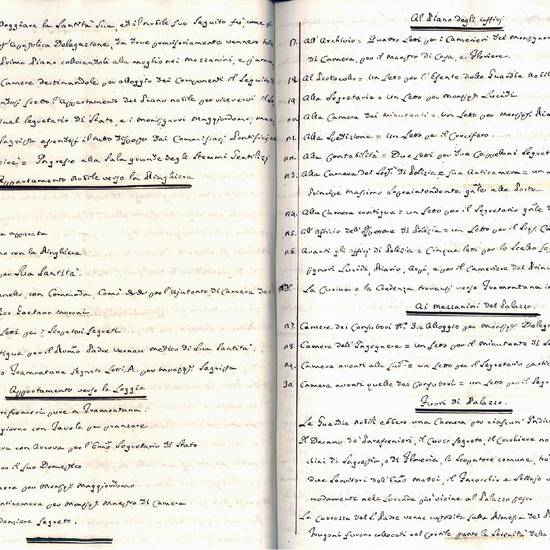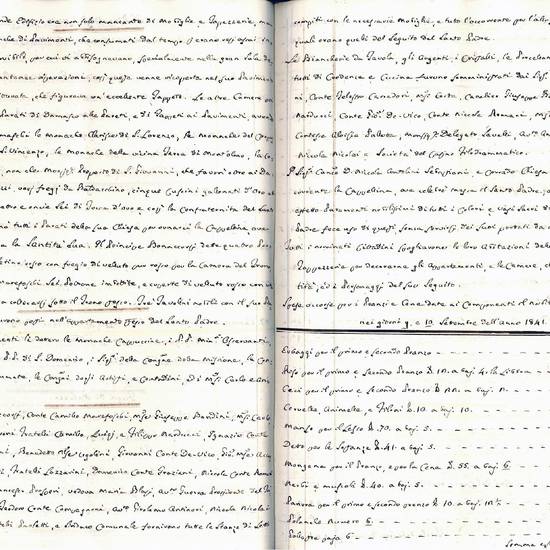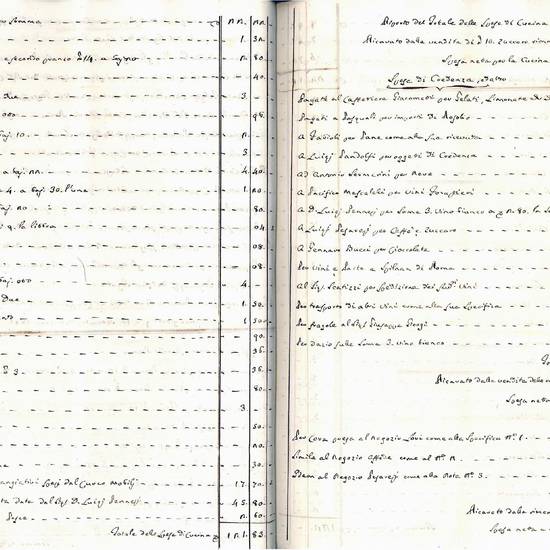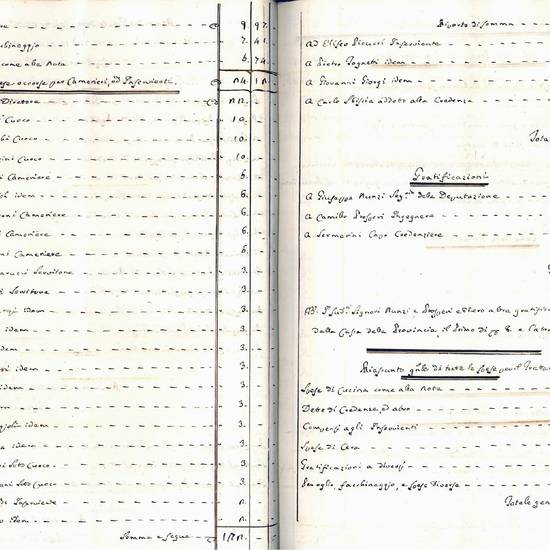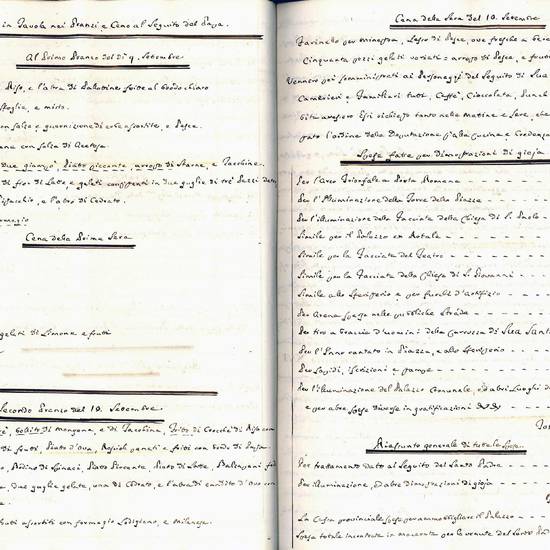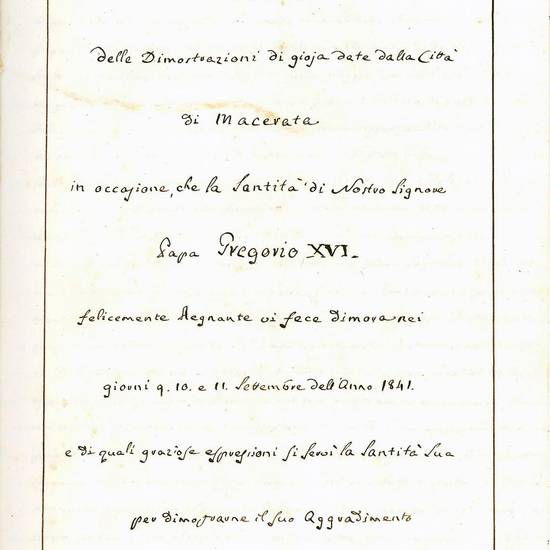Relazione delle Dimostrazioni di gioja date dalla città di Macerata in occasione, che la Santità di Nostro Signore Papa Gregorio XVI. felicemente Regnante vi fece dimora nei giorni 9. 10. e 11. Settembre dell'Anno 1841. e di quali graziose espressioni si servì la Santità Sua per dimostrarne il suo Aggradimento. Scritta da Antonio Natali li 10. di Ottobre dell'istesso anno 1841. Manuscript on paper. Macerata, 10 October 1841
Autore: MACERATA-GREGORIO XVI (1831-1846)
Tipografo:
Dati tipografici:
THE POPE'S MENU
Folio (298x205 mm). 26 leaves (the last is a blank), recently numbered [1: title page], 1-24, [1 blank]. Written in a neat and elegant hand. Title page within linear border. Bound in late 19th-century richly gilt brown morocco signed by Giresta, recently adapted to the volume by the addition at the end of about sixty-five blank leaves. In very good condition.
The manuscript contains an unknown and so far unpublished report of the festivities, ceremonies and banquets, with relative expenses occurred, for the stay of Pope Gregory XVI in Macerata on 9-11 September 1841.
On 19 August 1841 rumours arrived from Rome, including that of the powerful newly elected substitute of the Secretariat of State Giacomo Antonelli, of an imminent sojourn of the pope in Macerata. Gregory XVI had decided to make a “diplomatic” trip to all the cities, towns and large villages of Umbria and Marche, at the time in the territory of the Vatican State. The official purpose of the trip was the visit to the Sanctuary of Loreto, but it seems clear also the desire from the Pope to show to the people of those areas his support and affection, after the turbulences caused by the recent annoying presence there of the Austrian and French troops following the uprisings of 1830-‘31.
The news of the pope's arrival, as one can well imagine, greatly excited not only those who were supposed to organize the reception but all of the citizens. The Gonfaloniere, Baron C. Narducci Boccaccio, summoned on the evening of August 19 an extraordinary city council which decided to assign the Gonfaloniere himself and the local magistrates the sum of 2000 scudi and even more, if necessary, for the organization of the event. With this authorization Narducci Boccaccio elected a committee, composed of Count T. Campagnoni, Count T. Carradori and Marquis C. Costa, and charged with the task of restoring, furnishing and embellishing the legation palace, where the Pope was supposed to stay. A guard of honour was also appointed of twelve good-looking young men, chosen from among the “primary patrician families”, but in the end it was not activated as the Holy Father made it clear that he did want only his noble guards. Churches and main palaces were urged to contribute to the event with an extraordinary illumination and decorations with which to embellish the buildings along the path of the papal procession. Antonio Natali, author of this report, was responsible for that. The enthusiasm was such that it was decided to erect a monumental gate that would be called Porta Gregoriana, which in the end, however, was never built. From the Vatican came Messrs. Bertazzoli and Spagna as extraordinary commissioners to verify that everything was proceeding according to the ceremonial.
The Pope left Rome on August 30 and, after visiting Camerino and Tolentino, arrived in Macerata on September 9 at 10 am, stopping in front of Palazzo Ugolini lavishly decorated. The relation reports the costumes of the prominent people who came to greet him, the welcoming oration, the handing over of the city keys, and numerous other celebrative events. A religious service was then held in the Cathedral accompanied by much music, in particular the antiphon Tu es Petrus (l. 3v). After a meeting with the professors of the university, there was a lunch to which senior prelates and high priests were invited. The Holy Father visited, among others, the Convent of the Capuchin Nuns, to whom he allowed the kissing of the Holy Slipper; he did the same with some magistrates, nine ladies and three civilized women. Everything in town was magnificently illuminated and fireworks were exploded. The same was repeated on the second evening. The report describes in great detail these fireworks “of joy”, the facade of the churches and the most beautiful palaces, often illuminated “by drawing”, that is, with the lights following the contours of the buildings, up to the highest towers and bell towers (l. 6v).
One of the most interesting events narrated in the report is Gregory XVI's visit to the Borgettiana Library, where he saw two Polyglot Bibles and a Pater noster written in 150 languages. Being a person of great erudition, the pope felt perfectly at ease talking with the librarian Mons. Rutili about the new typefaces created in Rome under the guidance of Card. Mezzofanti to replace those stolen by the French a few years earlier. The Pope then went on to visit the other part of the library dedicated to the benefactor Bart. Mozzi (the two institutes merged into one only in 1855). The visit ended with the presentation to the Pope of a Homer translated into eight languages and richly bound, donated to him by Mons. Jacopo Antonelli (c. 8v).
The report of all the festivities that followed is very detailed and accounts for almost every slightest movement of the pontiff, who also visited the recently inaugurated “Sferisterio”, the pride of the Maceratesi, who consider it unique in Italy. The most official part of the report is represented by the numerous Latin epigraphs (all of them transcribed with a layout identical to that of the originals) scattered around the city and reaches its summit with Natali's Oration celebrating the building of the so-called Porta Gregoriana, which never occurred.
On the last day, after resting in the country house of Count Mattei, the Pope continued his journey to Loreto. At the end of the report Natali, by praising everyone, from Prince Bonaccorsi to the most humble servants, for the perfect success of the event, lets the reader glimpse at the feverish agitation of the days preceding the visit and those of the visit itself.
All the precious objects presented for the occasion (table linen, silverware, crystals, porcelain, kitchen items, valuable furniture) were returned intact; so was the bed that the pope found in his room in the palace assigned to him and which he judged comfortable enough, thus avoiding having it replaced with the one brought from Rome (we learn from that passage that the popes or at least this pope did not limit himself to carrying only a pillow in his traveling).
At the end of the report (l. 18r) is a section entitled: Spese occorse per i pranzi e cene date ai Componenti del nobile Corteggio del S. Padre nei gg. 9 e 10 Settembre dell'anno 1841 (“Expenses incurred for the lunches and dinners given to the members of the noble Court of the Holy Father on 9 and 10 September of the year 1841”). It accounts for the “Food Expenses”, “Beverages Expenses”, “Waiters and Servants”, and “Gratifications”, to which are added the expenses made for the “Demonstrations of Joy” (i.e. the festivities), bringing the total expenses to 2671 scudi, not too far from the approved budget of 2000 scudi.
At this point, last but not least, it is worth mentioning that the report gives an account of the menus of the two lunches and two dinners offered to the Pope during his stay: a very interesting document of high gastronomy of this particular period.
The journey that Gregory XVI made to the Marches in 1841 and his stay in Macerata are also narrated in two printed booklets: that of Carlo Chiappini (Relazione dell'arrivo, dimora, e partenza del supremo Ponte Gregorio XVI in Macerata [...], Macerata, 1841) and that of Francesco Sabatucci (Del viaggio fatto dalla Santità di Nostro Signore Papa Gregorio XVI dal di Nostro Signore dal 30 agosto al di 6 ottobre 1841 [...], Rome, 1843), the latter also published by Gaetano Moroni in his Dizionario di erudizione storico-ecclesiastica (Venice, 1846, vol. XLI, p. 71 and following). Neither of these, however, contains the curious and captivating list of refined dishes nor the detailed list of all expenses; moreover, the two printed reports also omit many other significant facts and details of the Pope's visit, and it is not surprising as they are descriptions of only six pages each.
[8923]

